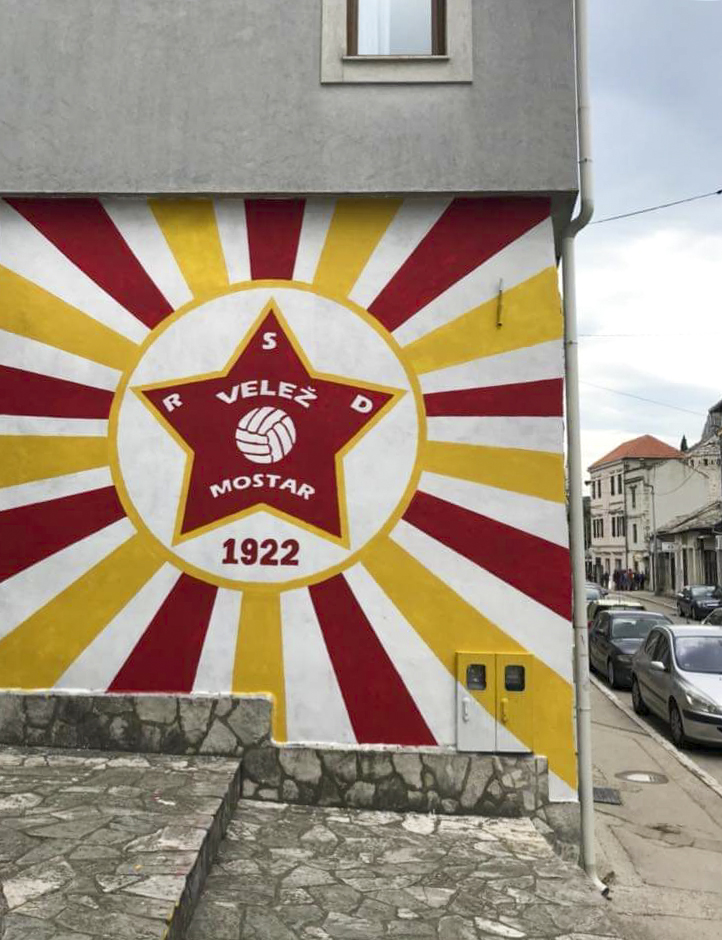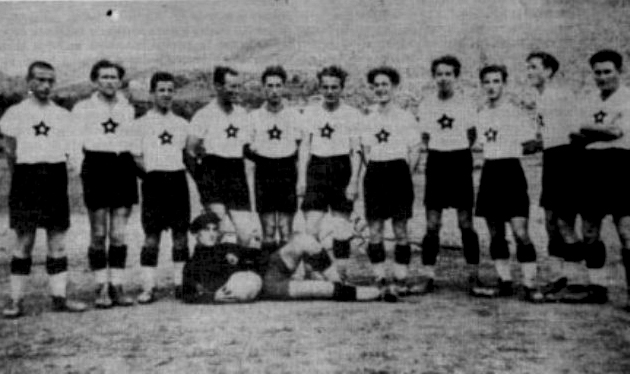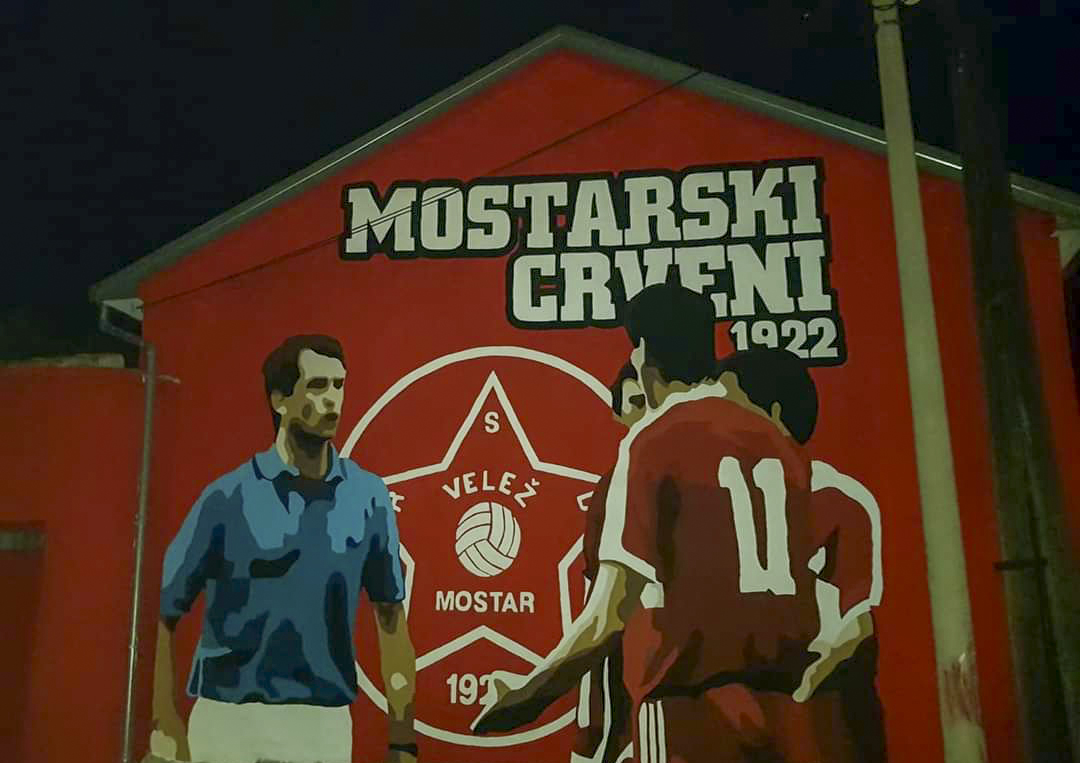The Mostar football club Velež played its last game at the Bijeli Brijeg Stadium in March 1992, only a couple of days before war spread to the city on the Neretva River. The stadium where Velež played that match, and many other previous ones, was built by Tito’s youth in the “work actions” that were organized in Yugoslavia after WWII to build public infrastructure.
However, 30 years later, Velež and its fans, the “Rođeni” and “Red Army,” have not yet returned to Bijeli Brijeg, which in the meanwhile was taken over by the “Croat Sports Club Zrinjski Mostar,” or just Zrinjski, another club from the city. The stadium thus became a type of war loot, while Velež, like many Mostar residents, moved to a new address. To this day, the football club remains a refugee three decades after the outbreak of war in Bosnia and Herzegovina.
The story of Velež, from its founding 100 years ago to today, is the story of Mostar, both the east and west banks of the city. This east-west divide is a wartime division that remains today. On the left bank on the eastern side of the Neretva River lives largely Bosniaks. On the right bank, the western side, largely Croats. Education, healthcare and even a considerable number of city utilities are also divided. So is football.

For 100 years, Velež has been a symbol of Mostar. Photo: Red Army Mostar.
Fan colors and graffiti show which part of Mostar belongs to which group. On the Boulevard of the People’s Revolution, the former frontline dividing the city during the war, red hydrants with five-pointed stars indicate that the area is under control of the Red Army, the ardent Velež fan group. Electrical boxes painted in red and white mark the turf of the Ultras, Zrinjski’s fan group. Everyone knows which sidewalk belongs to which group, who lays claim to the utility pole on the left or the dumpsters to the right,
Saša Ibrulj, a journalist, podcaster and fan of Velež, believes that things should be put “in proper perspective.”
“Today, Velež is different from how it was in 1922 or 1952 or 1992; it has evolved along with the city and the society that it exists in,” said Ibrulj.
Wartime divisions
The war in Mostar, as in the rest of Herzegovina, had two phases. The first stage began in April 1992 and lasted for about a year, while the second one began in May 1993 and lasted until the middle of 1994. In the first stage, military and police forces of Republika Srpska, supported by the Yugoslav People’s Army, attacked Mostar and Bosnia. The city was successfully defended by its residents.
However, in the spring of 1993, violence erupted between the Army of Bosnia and Herzegovina and the Croatian Defense Council (HVO), the latter enjoying support from Croatia. During this conflict the HVO held the east side of Mostar, including the Old Town, under siege. Around 10,000 refugees from the western side found shelter in the east after expulsion, while the HVO held more than 1,000 people in concentration camps.
The city’s Old Bridge, one of the symbols of Mostar, was destroyed in September 1993 after days of persistent shelling. It was rebuilt by 2004 and soon became a UNESCO World Heritage Site.
Mostar became a city with two football clubs, one in which the majority were Bosniaks and another that was exclusively Croats.
The conflict ended in 1994 with the signing of the Washington Agreement. The agreement recognized the wartime divisions in this part of the country and established the Federation of Bosnia and Herzegovina which the 1995 Dayton Accords would recognize as one of the two entities constituting the state. In the entity governing duties would be shared between ethnic Croats and Bosniaks.
During the war, Mostar became a city with two football clubs, one in which the majority were Bosniaks and another that was exclusively Croats. While the Velež fan group includes people from various ethnic groups — the majority of whom uphold the antifascist working class traditions of the club — Zrinjski supporters are often associated with extreme nationalism.

Velež in 1939. Most of the players joined the partisan movement during World War Two. Photo: Velež archive.
In 1993, Zrinjski moved to Bijeli Brijeg, known in Mostar as Velež’s home. Since it competed in the Independent State of Croatia’s (NDH) football league during WWII, the club was banned in Yugoslavia. But the leaders of Herzeg-Bosnia, later convicted of war crimes by the Hague Tribunal, restored Zrinjski as a Croat football club in 1992. This national element is reflected in the club anthem, which begins with the words “Zrinjski is a glorious Croat name.”
Velež did not play at all between 1992 and 1994. A number of players were forced to replace their jerseys with military uniforms, like many other residents of Mostar.
A similar fate befell Velež and Mostar in WWII. The club played its last pre-war game in 1940, when Mostar was already occupied by the NDH. It went down in club history that the match versus Crna Gora Podgorica was suspended after Velež supporters started chanting, “Death to fascism,” “Death to imperialism,” and “Down with all tyrants — long live freedom!” NDH police stormed the stands, arrested fans and took a number of them to the Lepoglava concentration camp.
Over the course of WWII, many Velež supporters and most of its players joined the partisans. Nine of them — eight posthumously — were awarded the Order of the People’s Hero after the war.
Velež was the pride of Mostar in Yugoslavia. A major league club in a country where a lot of good football was played, Velež won Yugoslav cups and was playing on the European scene in the 1970s. One of Velež’s greatest players was Vahid Halilhodžić, who played for Nantes and Paris Saint Germain after his tenure with Velež. In the 1980s, he was named the best player in the French league. A number of other football legends also played for Mostar, including Sergej Barbarez, Blaž Slišković, Meho Kodro and Dušan Bajević.
The passionate Velež supporter, writer and journalist, Marko Tomaš, said that Velež is one of the few remaining things linking the city with its rebellious past. “It’s good that it serves as a reminder of such a past,” he said. “Like some kind of bad conscience. Again, it means that, unlike others, we at least have a conscience.”
Refugees in their own city
Referring to his beloved club, Muamer Kodrić, the editor of the magazine Forza Velež!, said that Velež was founded as a “workers’ sports association” that brought together the working class and what was called the “progressive intelligentsia” in Yugoslavia. “So, since its very foundation, by the will of its co-founders and supporters, Velež has been a club that as a sports association decides to, let’s say, promote ideas considered socially progressive and also beneficial to its fans and supporters,” said Kodrić.
In 1994, amid the war, Bosnia and Herzegovina set up its own football league and Velež played in it. However, the club still cannot play at its own stadium. In the post-war years, the club management asked for help from the Office of the High Representative so they could return to their home ground, but they did not receive help. To this day they remain refugees in their own city.
Velež has supporters across the territory of what was once Yugoslavia.
The two Mostar-based clubs, Velež and Zrinjski, have been meeting in city derbies since 2000 and are now both part of a unified league of Bosnia and Herzegovina. However, most of these derbies are considered high-risk events that are often accompanied by clashes of fans that spill over into the rest of the town. In those instances, the invisible dividing line, the Boulevard, becomes a battleground where the Red Army and Ultras engage in violent brawls.
Velež has supporters across the territory of what was once Yugoslavia, supporters who consider the club a symbol of revolution. This symbol is one of the things anchoring Marko Tomaš to Velež. In 2021, he wrote a short essay about the club, in which he said that Velež has endured not because of its structure, but because of people.
“As for me, I won’t mind if Velež doesn’t win anything as long as it survives to annoy snobs and nationalist pricks with its history and symbols,” said Tomaš, noting that resistance and defiance have been going hand in hand with Velež ever since its foundation. “Even if we were in the lowest tier of Bosnian football, this would be the only thing that would matter to me.”

In one part of the city there are murals dedicated to Velež, in other parts, to Zrinjski. Photo: Red Army Mostar.
According to the journalist, sociologist and Velež supporter Amer Bahtijar, in today’s Mostar, the club serves as a testament to survival and a memory of the period “when this part of the world was truly multi-ethnic and when the most progress was made for the most people.” Bahtijar adds that he is very well aware that Velež as it is today widely reflects the reality of the so-called East Mostar, that is, its “non-existence in existence,” as he defines the situation.
“Today, Velež is a great club again and it’s precisely as a serious, well-organized club that it’s turning into a symbol of the triumph of life over darkness,” said Bahtijar.
Nowadays, people in Mostar say that Velež is a social necessity. “Velež is in some sort of an in-between, where the club as a phenomenon is aware of its current environment and its own position within it, but also equally aware of its value as a symbol of the struggle for ideals throughout the history of the city history,” said Saša Ibrulj, adding that without Velež, there’s no Mostar.
Feature image: Red Army Mostar.




